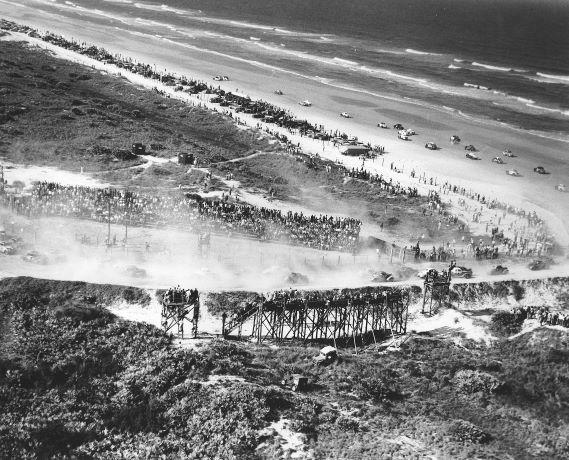The First NASCAR Rule Book
by Tom Jensen February 02, 2023
Not surprisingly, the rules in NASCAR’s first season of 1948 were quite a bit different than you’d find today.
Today’s NASCAR rule book is housed online, with detailed technical drawings and precise dimensions and measurements to make sure every piece and part on a car conforms exactly to its intended specifications.
Things were a little simpler 75 years ago.

The Modified Division competed at dirt tracks throughout the South in NASCAR’s first season of 1948. Photo courtesy of NASCAR Archives & Research Center via Getty Images
In 1948, NASCAR’s first year of operation, NASCAR’s highest class was known as the NASCAR Modified Division (now NASCAR Whelen Modified Tour). The first rule book was a simple piece of paper, printed on both sides and folded. A copy of that first rule book is on display in the NASCAR Hall of Fame’s Heritage Speedway exhibition. It’s a fast read, as the rules were minimal back then.
The 1948 NASCAR rule book listed the sanctioning body’s Commissioner, E.G. “Cannonball” Baker, its Board of Governors, led by President William H. G. France (Class of 2010), and its Technical and Competition Committees, each of which featured 10 members.
There were also separate rules for NASCAR’s short-lived Roadster Division.

NASCAR’s Roadster Division allowed racers virtually unlimited modifications. Unfortunately, the series didn’t catch on and was quickly dropped. Photo courtesy of NASCAR Archives & Research Center via Getty Images
Some of the highlights from the 1948 rule book:
Cars eligible for the Modified Division had to be manufactured between 1937 and 1948. Cars built in 1937 and ’38 had to be fitted with four-wheel hydraulic brakes.
No foreign manufactured cars were permitted.
Convertibles had to be raced with their tops up and fastened in place and were required to have frame-mounted safety hoops.

Pre-World War II Ford coupes were a staple of NASCAR racing in the late 1940s. Photo courtesy of NASCAR Archives & Research Center via Getty Images
All cars had to have full stock fenders, running boards and bodies if equipped by the factory, but their bumpers and mufflers had to be removed. Also, a car’s wheelbase, length and width had to remain stock, as did the hood. Racers could use any radiator they wanted as long as it fit under the stock hood, which had to be secured with safety straps.
Oversized or extra oil and fuel tanks were allowed, but they had to be either concealed inside the car or under the hood.
In most cases, engines were limited to 300 cubic inches.
Any interchangeable wheel or tire was allowed.
Multiple carburetors were permitted, while superchargers were allowed only when optional on stock equipment.
Also approved in the 1948 rule book were custom camshafts and crankshafts.
Each race car was subject to safety inspection by the Technical Committee at any time.
Drivers were required to wear safety helmets and use seat belts that were bolted to the frame in two points, with a quick-release system to unlatch the belts.

Photo courtesy of Tom Jensen

NASCAR’s 1948 rule book was printed on a single sheet of paper. Photo courtesy of Tom Jensen
The rules for the Roadster Division were considerably more liberal. Stock American block engines were permitted, with almost limitless modifications to the engine and its components, transmissions and rear ends.
Wheelbases of 90-120 inches were allowed and shock absorbers were required at all four corners of the car. “They may be of any type providing they work efficiently,” the rule book stated.
Homemade or factory bodies were allowed.

Daytona Beach hosted the first official NASCAR points race in 1948. Photo courtesy of NASCAR Archives & Research Center via Getty Images
As far as officiating the race, the rule book stated, “In all NASCAR-sanctioned races, when the checkered flag is given to winning car, the race is over and all cars will stop on that lap. Finishing positions will be paid according to distance run, whether car is still running or not. …No race shall be run over 5 laps on the caution flag without stopping the race. This is to be at the discretion of the steward.”
If a driver wanted to protest the outcome of the race, he had to deposit $500 (about $6,100 in 2023 dollars) with a NASCAR official within 10 minutes of the conclusion of the race. If the driver lost the protest, the $500 was applied to NASCAR’s hospital fund.
And NASCAR specified that “These rules are subject to change on recommendation of the Committee. Notice of any rule changes or additions will be sent to NASCAR members from national headquarters.”
Plan your visit to the NASCAR Hall of Fame and purchase tickets by visiting nascarhall.com/tickets.













